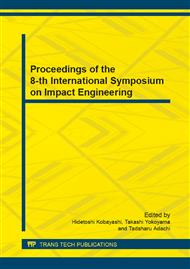p.443
p.449
p.457
p.463
p.468
p.474
p.480
p.486
p.493
Finite Element Simulation of Brittle Fracture of Bulletproof Glass System
Abstract:
The thickness and weight of a bulletproof glass material can be reduced using strengthened glass possessing current protective abilities. In this study, numerical simulations are used to estimate the protective ability of strengthened borosilicate glass used in bulletproof glass systems. High-velocity impacts and perforation behaviors are well described by a dynamic brittle fracture model. A parametric study of the material model of glass is conducted by comparing test results of individual impacts with corresponding numerical estimations; size of back-surface spall, morphology of perforated surface, and fractured areas are compared. Material parameters of strengthened and nonstrengthened borosilicate glasses are determined. Numerical simulations using a material model with these parameters well describe the overall fracture behavior of bulletproof glass. The main parameters that affect the protective ability are initial compressive yield stress and fracture stress. Furthermore, the protective ability of strengthened borosilicate glass is ~20% better than that of nonstrengthened borosilicate glass.
Info:
Periodical:
Pages:
468-473
Citation:
Online since:
June 2014
Authors:
Keywords:
Price:
Сopyright:
© 2014 Trans Tech Publications Ltd. All Rights Reserved
Share:
Citation:


